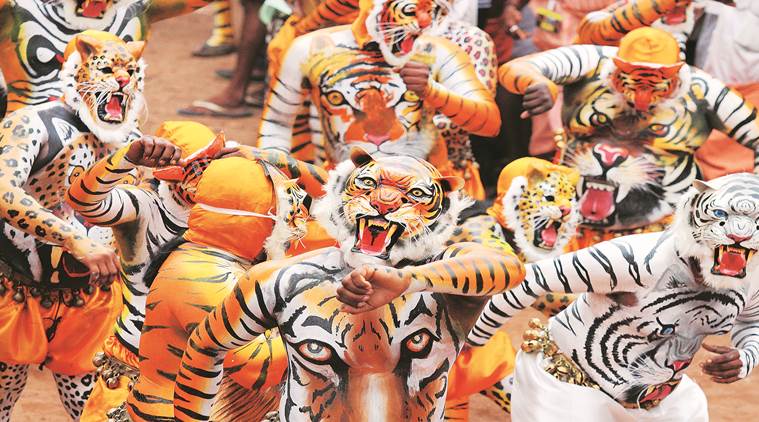- India
- International
During Onam, the annual Pulikali festival in Thrissur sees people get into the skin of the tiger
In the processions, many have the feline’s face painted on their bellies and stripes on their limbs, others are wearing costumes, while some have donned masks.
 While the processions roll out in the afternoon and celebrations go on till 9 pm, the preparations begin the night before. (Source: Getty/Thinkstock)
While the processions roll out in the afternoon and celebrations go on till 9 pm, the preparations begin the night before. (Source: Getty/Thinkstock)
Written by Syed
Fist clenched, arms outstretched. Belly jiggles and feet forward. Golden, orange, green and pink — a profusion of hues shimmers and dazzles amidst gyrating black bands. The tigers are marching despite sudden showers. The thunder, however, is down in the streets, percussing from jackfruit wood, tamarind bark, hide and metals.
It is Onam and the annual Pulikali (tiger play) festival has engulfed Thrissur in Kerala. All roads lead to the Swaraj Round, a green patch in the heart of the city with the grand Vadakkunnathan Temple at its centre. In the processions, many have the feline’s face painted on their bellies and stripes on their limbs, others are wearing costumes, while some have donned masks.
While the processions roll out in the afternoon and celebrations go on till 9 pm, the preparations begin the night before. “We first have to shave our body hair. Then, we need multiple coats of paints of different colours to get the right look,” says Bharath Santosh, a student clad in golden breeches. This is his first Pulikali as a dancer with the Friends Arts and Sports Club.
There are many such clubs in Thrissur, each with their troupes of dancers, chenda melam (percussion orchestra), painters and tableaux. All of them start from their respective neighbourhoods and congregate at the Swaraj Round in a friendly face-off to perform the best tiger dance. The government gives them awards under various categories such as “best tableau”, “best rhythmic beats”and “best tiger costume”. There’s even one for “discipline and decorum”!

Throughout the morning, small groups with chendas walk the streets, spreading festivity into the air. At the tent set up by the Friends Arts and Sports Club, there is a flurry of action. Artists are painting tigers, leopards and zebras on the men’s bodies. After each coat, the performers stand feet apart, hands resting on bamboo poles, waiting for the paint to dry. The humidity and sharp sun make it an uncomfortably torrid affair, but nobody seems bothered.
 Roaring revelry: Women and men during Pulikali. (Express photo by Syed)
Roaring revelry: Women and men during Pulikali. (Express photo by Syed)
Around 4 pm, the processions begin. Crowds have collected along alleys and on rooftops to watch the tigers. They walk out lavishly costumed to loud cheer. After paying obeisance at the local shrine, they move to the city’s thoroughfares and begin performing in small groups. The fairly simple moves are said to be modelled on a tiger stalking its prey. As they groove, their waist belts, festooned with bells, create a distinctive rhythm. The men with the biggest bellies are most in demand — not only do their paunches offer a larger canvas for more expressive paintings, they are the ones adding the most bounce to the beat.
The dancers are not the only spectacle though — there are also grand tableaux piggybacking on trucks. While some have mythological themes, others are rather eclectic. One has a world map made obscure by a spouting blue whale and a 6-ft-tall cutout of a mobile phone. The most fascinating, however, is the recreation of Kevin Carter’s iconic photograph of a vulture stalking a starving girl, taken in Sudan in 1993.
Online Chinese whispers contend the festival originated more than 200 years ago under the tutelage of the then Maharaja of Cochin, Sakthan Thampuran (whose palace in Thrissur is now a museum), while others speculate it is 40-70 years old. But CG Prince, a sculptor and folklorist from Thrissur who has been studying and participating in the festival as a painter for 30 years, denies these claims. “I have talked to older residents and can say with certainty that the festival is at least 100 years old. It is a synthesis of the Tamil Nadu folk dance of Puliyattam, which was performed during Pongal, and the Muslim festival of Muharram. Puliyattam has its origins in shepherd culture and features depictions of tigers preying on goats. Since Muslims regard Ali (whose family’s martyrdom is commemorated during Muharram), as the tiger of Allah, they dress up as the beast and perform a kind of tiger dance during Muharram. In Kerala, these two traditions were synthesised into Pulikali.”
This eclecticism is also visible in the tourist attractions of Thrissur, anointed the “cultural capital” of Kerala. In the city, there are several historic churches: Our Lady of Lourdes, Basilica of Our Lady of Dolours and Marth Mariam, the headquarters of India’s Chaldean Syrian community. An hour’s drive from the city is Cheraman Juma Mosque, considered the oldest Muslim shrine in the subcontinent. But most of all, Thrissur is known for its exuberant celebrations: Thrissur Pooram, which outshines all other temple festivals with its caparisoned elephants, kudamattam (a colourful parasol display) and fireworks; and Pulikali.
However, unlike the grand Thrissur Pooram, the extravaganza of Pulikali masks a disconcerting trend — with every passing year, it’s becoming harder for the clubs to foot the Rs 15-20 lakh cost of organising the jamboree. In 2017 and 2019, only six teams participated; over a dozen used to take part a decade ago. Unlike many state or temple-sponsored festivals, Pulikali is a people’s event — while the clubs get some money from the government and corporate sponsorships, they are largely crowdfunded and organised with the help of volunteers. The festival’s future might be as insecure as its inspiration in the forest, but for now, the tigers’ roars are loud and joyous in Thrissur’s urban jungle.
(Syed is a Delhi-based writer)
Apr 23: Latest News
- 01
- 02
- 03
- 04
- 05






































